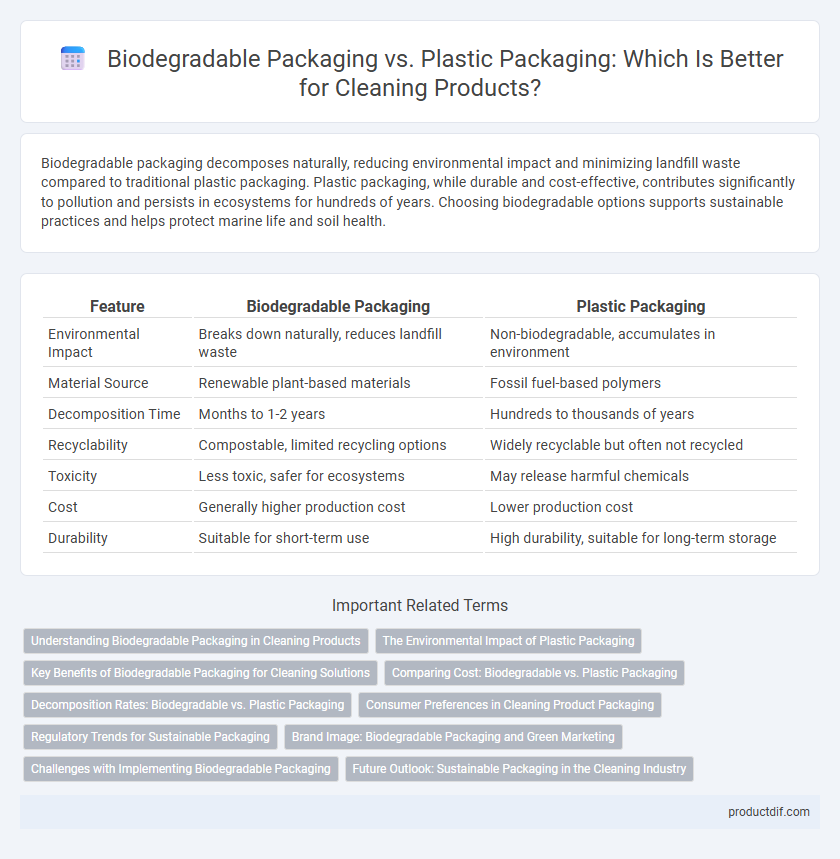Biodegradable packaging decomposes naturally, reducing environmental impact and minimizing landfill waste compared to traditional plastic packaging. Plastic packaging, while durable and cost-effective, contributes significantly to pollution and persists in ecosystems for hundreds of years. Choosing biodegradable options supports sustainable practices and helps protect marine life and soil health.
Table of Comparison
| Feature | Biodegradable Packaging | Plastic Packaging |
|---|---|---|
| Environmental Impact | Breaks down naturally, reduces landfill waste | Non-biodegradable, accumulates in environment |
| Material Source | Renewable plant-based materials | Fossil fuel-based polymers |
| Decomposition Time | Months to 1-2 years | Hundreds to thousands of years |
| Recyclability | Compostable, limited recycling options | Widely recyclable but often not recycled |
| Toxicity | Less toxic, safer for ecosystems | May release harmful chemicals |
| Cost | Generally higher production cost | Lower production cost |
| Durability | Suitable for short-term use | High durability, suitable for long-term storage |
Understanding Biodegradable Packaging in Cleaning Products
Biodegradable packaging in cleaning products breaks down naturally through microbial activity, reducing environmental impact compared to conventional plastic packaging, which persists for hundreds of years. Made from renewable materials like plant-based polymers or starch composites, biodegradable packaging minimizes landfill waste and promotes sustainability. This eco-friendly option aligns with increasing consumer demand for green cleaning solutions while maintaining product integrity and safety.
The Environmental Impact of Plastic Packaging
Plastic packaging significantly contributes to environmental pollution due to its non-biodegradable nature, persisting in ecosystems for hundreds of years. The production and disposal of plastic packaging release greenhouse gases and toxic chemicals, harming wildlife and contaminating soil and water sources. In contrast, biodegradable packaging decomposes naturally, reducing landfill waste and minimizing ecological damage.
Key Benefits of Biodegradable Packaging for Cleaning Solutions
Biodegradable packaging for cleaning solutions significantly reduces environmental impact by decomposing naturally, preventing long-term plastic pollution. It enhances brand reputation through eco-friendly appeal, attracting environmentally conscious consumers seeking sustainable products. Furthermore, this packaging often uses renewable resources, lowering carbon footprints and supporting circular economy goals.
Comparing Cost: Biodegradable vs. Plastic Packaging
Biodegradable packaging for cleaning products generally incurs higher initial costs than traditional plastic packaging due to raw material expenses and production complexity. However, long-term savings appear from reduced environmental impact fees and improved brand reputation among eco-conscious consumers. Plastic packaging remains cheaper upfront but may face increasing regulatory costs and consumer pushback as sustainability becomes a priority.
Decomposition Rates: Biodegradable vs. Plastic Packaging
Biodegradable packaging decomposes within months to a few years, significantly reducing environmental impact compared to plastic packaging, which can take up to 500 years to break down. Microbes, heat, and moisture accelerate the breakdown of biodegradable materials, while plastic's chemical structure resists natural decomposition. Choosing biodegradable packaging helps cut down landfill waste and lowers toxic residue in ecosystems.
Consumer Preferences in Cleaning Product Packaging
Consumer preferences in cleaning product packaging increasingly favor biodegradable materials due to heightened environmental awareness and demand for sustainable solutions. Studies show that over 65% of consumers prioritize eco-friendly packaging when purchasing cleaning products, associating biodegradable options with reduced environmental impact and improved brand trust. Despite the lower cost and durability of plastic packaging, the growing preference for biodegradable alternatives drives manufacturers to innovate and adopt sustainable packaging designs.
Regulatory Trends for Sustainable Packaging
Regulatory trends increasingly favor biodegradable packaging over plastic packaging due to global commitments to reduce environmental pollution and plastic waste. Governments in regions like the EU and North America are implementing stricter regulations and incentives to promote the use of compostable materials in cleaning product packaging. Compliance with these evolving sustainability standards is essential for manufacturers aiming to meet consumer demand and avoid penalties associated with single-use plastics.
Brand Image: Biodegradable Packaging and Green Marketing
Biodegradable packaging significantly enhances brand image by aligning with eco-conscious consumer values and demonstrating corporate environmental responsibility. Brands adopting green marketing strategies with biodegradable packaging often experience increased customer loyalty and a competitive advantage in the cleaning product market. Plastic packaging, conversely, can harm brand reputation due to growing public concern over pollution and sustainability.
Challenges with Implementing Biodegradable Packaging
Biodegradable packaging for cleaning products faces challenges such as higher production costs and limited availability of raw materials compared to traditional plastic packaging. The inconsistent performance and shorter shelf life of biodegradable materials can affect product stability and consumer acceptance. Additionally, inadequate waste management infrastructure hinders the effective composting or degradation of biodegradable packaging, reducing its environmental benefits.
Future Outlook: Sustainable Packaging in the Cleaning Industry
Biodegradable packaging is expected to dominate the cleaning industry as consumer demand shifts towards eco-friendly and zero-waste solutions, reducing plastic pollution and enhancing brand sustainability. Innovations in plant-based materials and compostable polymers are driving the scalability and cost-efficiency of biodegradable alternatives, making them viable replacements for traditional plastic packaging. Regulatory pressures and corporate commitments toward carbon neutrality further accelerate the transition to sustainable packaging, positioning biodegradable options as the preferred choice for future cleaning products.
Biodegradable packaging vs Plastic packaging Infographic

 productdif.com
productdif.com